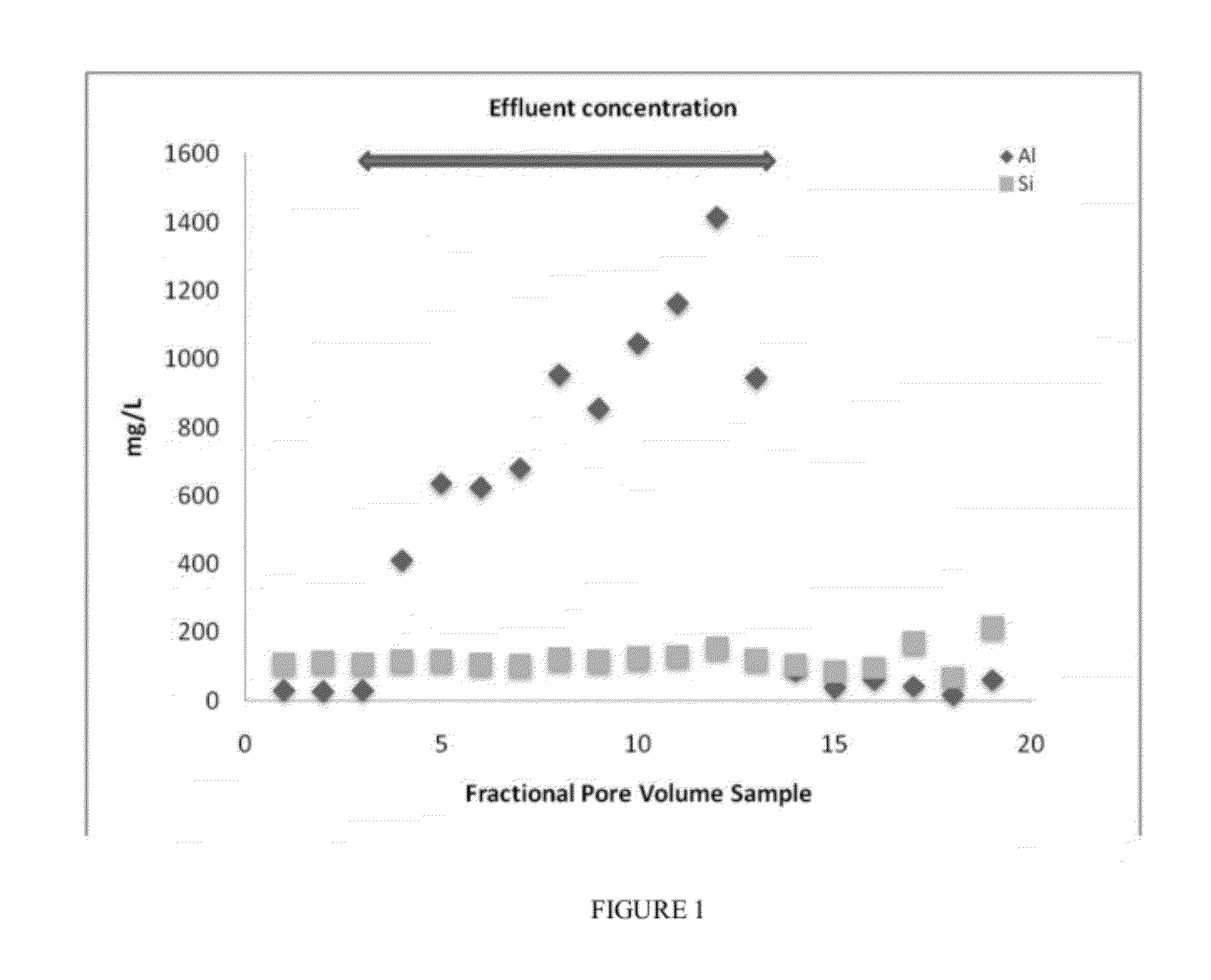Treatment Fluids Containing Biodegradable Chelating Agents and Methods for Use Thereof
a technology of biodegradable chelating agents and treatment fluids, which is applied in the direction of sealing/packing, cabinetry, borehole/well accessories, etc., can solve the problems of negative skin value, small or no treatment effect of siliceous formations with chelating acids, and inability to achieve positive skin valu
- Summary
- Abstract
- Description
- Claims
- Application Information
AI Technical Summary
Benefits of technology
Problems solved by technology
Method used
Image
Examples
experiment 1
[0056]A solution of DISSOLVINE® (GLNA40S) available from AkzoNobel was used in the preparation of the treatment fluid. A solution containing 3.5 wt. % of GLNA40S was prepared by dissolving 363.5 g of concentrated form into a base fluid. The base fluid consisted of 2% NaCl containing 20 g / L of tannic acid. After fully mixing all components, the pH of the final volume of solution (4 L) was adjusted to pH 1.6 with 35% HCl. The solution was filtered through a 0.40 micron membrane. It was stable for the duration of the testing period (days). A 2″×12″long Hassler sleeve was employed to conduct a core flood acid test at 320° F. The sleeve was packed with a homogenized mixture of quartz (Oklahoma #1 sand) (94 wt. %), K-feldspar (2 wt. %), and the aluminosilicate chlorite (4 wt. %). The pore volume (PV) of the packed column corresponded to 110 mL.
[0057]The column was treated with the following fluid sequence:[0058]4 PV, 2% NaCl (pH 6),[0059]2 PV, 3.5% GLNA40S (pH 1.6) with Tannic acid,[0060]...
experiment 2
[0063]The following description corresponds to visual observations, and titrations conducted. All tests, including the core flood (describe above in Experiment 1), made use of a fluid consisting of DISSOLVINE® GLDA (GL-NA40S) and tannic acid.
[0064]The solubility of Al3+ in concentrations of 200 to 3000 ppm was independently tested at room temperature. 100 mL of a stock solution (1.45 M pH 1.45) was placed in a stirred beaker, and the pH was gradually raised with strong base (1 M NaOH or 2 M NH4OH in order to minimize volume changes due to dilution). Precipitation of aluminum hydroxide ensued shortly after reaching pH 2.5 and nearly fully precipitated quantitatively at pH 3 in the absence of any chelating agent. When GLDA was employed in concentrations of 3.5 wt. % or 12 wt. %, precipitation was effectively suppressed as the pH increased from the starting pH of 1.45 to 4. After reaching pH 4, a relatively minor amount of flocculated particles were evident, but no precipitate formed f...
experiment 3
[0065]A glass vial containing 5 g of mineral (clay or quartz) was mixed with 15 or 20 mL of treatment fluid. The treatment fluid was composed of GLDA 15 wt. % and 3 wt. % NH4HF2 with sufficient HCl to adjust the pH to the indicated value in Table 2 below. The reaction mixtures were heated in a heated cylinder to 95° C. for 0.5, 1, 2, 3, 4 hours and automatically shaken (at 200 rpm). The reaction fluid was collected via a syringe and filtrated through a 0.45 micron membrane filter prior to ICP-AES analysis, the pH of the solution was not adjusted via any means. The elemental analysis for each mineral is provided in Table 2.
[0066]It is noteworthy to point out that the point of these experiments was not to optimize the fluid composition, but rather show the effectiveness of the GLDA even in the presence of a hydrofluoric acid generating compound like ammonium bifluoride. While there are sodium pentafluorosilicates and hexafluorosilicates, known damaging precipitates resulting from the ...
PUM
| Property | Measurement | Unit |
|---|---|---|
| temperatures | aaaaa | aaaaa |
| wt. % | aaaaa | aaaaa |
| pKa | aaaaa | aaaaa |
Abstract
Description
Claims
Application Information
 Login to View More
Login to View More - R&D
- Intellectual Property
- Life Sciences
- Materials
- Tech Scout
- Unparalleled Data Quality
- Higher Quality Content
- 60% Fewer Hallucinations
Browse by: Latest US Patents, China's latest patents, Technical Efficacy Thesaurus, Application Domain, Technology Topic, Popular Technical Reports.
© 2025 PatSnap. All rights reserved.Legal|Privacy policy|Modern Slavery Act Transparency Statement|Sitemap|About US| Contact US: help@patsnap.com

